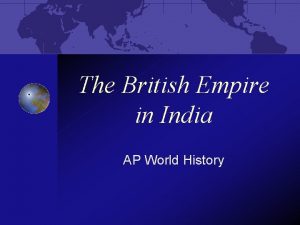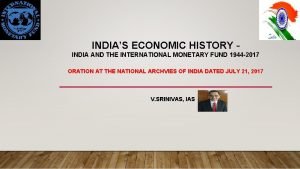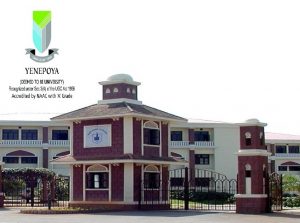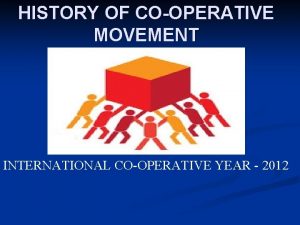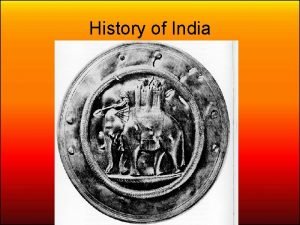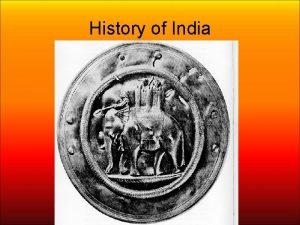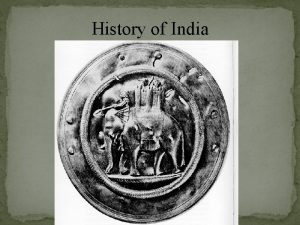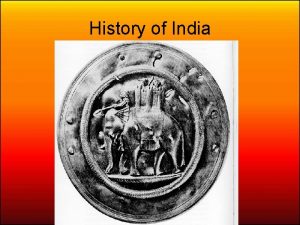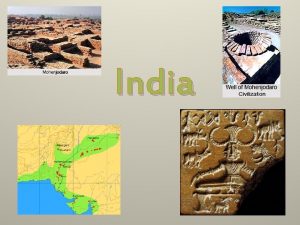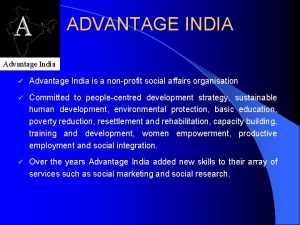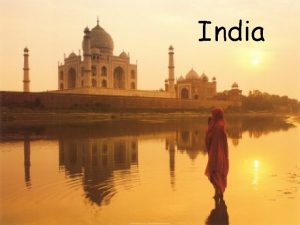50 Minute Tour of the History of India






























- Slides: 30



50 Minute Tour of the History of India

Before the Guptas in India n Two major empires rose to unify the region that would become India 1. Mauryan Empire (326 BC – 184 BC) 2. Kushan Empire (30 AD – 360 AD)

Mauryan Empire (326 BC – 184 BC) India’s recorded history at this time pretty much ignored Alexander the Great's attempts to conquer the region in 326 B. C n But, cultural diffusion between India and Greek art, architecture, language and coinage was evident during the Mauryan Empire. n

Rise of Mauryan Empire n Alexander the Great died in 323 BC without ever conquering the Indian subcontinent. n As the Greek Empire retreated from South Asia, King Chandragupta took control over Magadha and conquered his way well into Afghanistan.



Reasons: King Chandragupta Maurya’s Success and the Mauryan Rise: 1. 2. 3. 4. 5. 6. Farming and trade around Ganges River Iron deposits in Magadha Kautilya, the Brahman author of the Arthashastra (Science of Material Gain) Very organized, highly structured government—excellent control over tax collection. Large standing army Well developed system of espionage

Emperor Ashoka renounced war and adopted a policy of nonviolence n He promoted religious and cultural tolerance. n Also personally worked to spread the teachings of Buddhism. He is famous for his public inscriptions. n Called his message of peace and love Dharma n

The Mauryan Empire reached its height of prosperity during the reign of Emperor Ashoku


Decline and Fall of Mauyan Empire 1. 2. 3. 4. Ashoka died in 232 BC During the last half of Ashoka’s reign, there were no military campaigns The military became weak from lack of practice. After Ashoka, there wasn’t another strong Mauyan leader.

The Kushan Empire (30 AD – 360 AD) The Kushan Kingdom was the meeting point of trade among the Indian, Persian, Chinese, and Roman empires and controlled a critical part of the Silk Road. n Kanishka, who reigned for two decades starting around A. D. 78, was the most noteworthy Kushana ruler. He converted to Buddhism and convened a great Buddhist council in Kashmir. n

The Kushan Empire The Kushans were patrons of Gandharan art, (a combination of Greek and Indian styles) and Sanskrit literature. n They declared a new era called Shaka in 78 AD, and this calendar was formally adopted by India in 1957. It is still in use today. n

Kushan Empire’s Decline n After the death of Vasudeva I in 225 AD, the Kushan empire split into western and eastern halves. n The remnants of the Kushan empire were ultimately wiped out in the 5 th century by the invasions of the Huns, and later the expansion of Islam.

The Gupta Dynasty (320 -550) Under Chandragupta I (320 AD -335 AD), empire was revived in the north. n First conquered Magadha, set up his capital where the Mauryan capital had stood n Chandragupta revived many of Ashoka's principles of government. n

Gupta Dynasty Chandragupta’s son Samudragupta (335376), and later his grandson, Chandragupta II (376 -415), extended the kingdom into an empire over the whole of the north and the western Deccan Plateau. n This period is regarded as the golden age of Indian culture. n Continued expansion of Buddhism n

Accomplishments of the Guptas Mathematics n n n Astronomy Invented a numeral n Identified seven system. planets. Developed a concept of n Determined that negative numbers. planets and moon Calculated square root reflect sun's light. of 2 n Understood daily Developed table of rotation of earth on its sines. axis. Computed value of Pi. n n Predicted eclipses. Developed theory of gravity.

Accomplishments of the Guptas Medicine Understood importance of spinal cord. n Knew how to set bones. n Performed plastic surgery. n Practiced sterilization of wounds n

Fall of the Guptas Beginning in the 400's AD, the Huns began to put pressure on the Guptas. n In 480 they conquered the Guptas and took over northern India. n Western India was overrun by 500 n The last of the Gupta kings died in 550. n

After the Fall of the Guptas Buddhism was interpreted in different ways in India n Theravada understanding of one’s self is the key to Nirvana. (strict) n Mahayana Nirvana can be achieved through devotion to Buddha is a divine figure. (less strict) n Then Hinduism gained popularity n

as Hinduism gained popularity n Theravada Buddhism almost disappeared Mahayana Buddhism was absorbed by Hinduism. n The introduction of Islam completed the decline of Buddhism in India. n

The Eastward Expansion of Islam reached South Asia after the fall of the Gupta Empire n After the Gupta Empire, there was no centralized power in the region. n The Indian subcontinent was divided into over 70 separate powers that were in constant conflict. n

Early Islamic States Near India Arab armies reached India in the 700 s AD n Mamluk Turkish soldiers established the Islamic state Ghazni in what would be Afghanistan. n Mahmud of Ghazni succeeded as Ghazni ruler after his father died in 997 AD n Attacked the nearby Hindu kingdoms and by Mahmud’s death in 1030 the Ghazni took over the Indus Valley. n


Sultanate of Delhi By 1200 a Muslim state called the “Sultanate of Delhi” had taken all of northern India. n During the 1300 s, the Sultanate of Delhi reached across the Deccan Plateau. n Soon after, 1369, Timur Lenk took control over the Mogul state in Samarkand aggressively began to expand the territory n


Fall of the Sultanate of Delhi n Timur Lenk attacked Delhi in 1398 and completely destroyed it. n After killing 100, 000 Hindu captives The last dynasty of the Sultanate was the Lodi dynasty n The last Lodi ruler, Ibrahim Lodi, was hated by his court and subjects n Alam Khan sent an invitation to Babur, the ruler of Kabul, to conquer Delhi. n

Islam and Indian Society n Muslim rulers in India saw themselves as foreign conquerors n They kept themselves strictly separate from the Hindu population n They were generally intolerant of Hinduism, and destroyed many Hindu temples n Conflict between Indian Muslims and Hindus continues to the present day.
 History world tour
History world tour Tour petronas et tour eiffel
Tour petronas et tour eiffel Differentiate between a guide and an escort.
Differentiate between a guide and an escort. 60 sec is 1 minute
60 sec is 1 minute British in india ap world history
British in india ap world history India imf loan history
India imf loan history Historical and contemporary perspectives in midwifery
Historical and contemporary perspectives in midwifery Explain the different objectives of microteaching
Explain the different objectives of microteaching Origin of pharmaceutical legislation in india
Origin of pharmaceutical legislation in india Evolution of banking in india
Evolution of banking in india Cooperative society principles
Cooperative society principles Hát kết hợp bộ gõ cơ thể
Hát kết hợp bộ gõ cơ thể Bổ thể
Bổ thể Tỉ lệ cơ thể trẻ em
Tỉ lệ cơ thể trẻ em Gấu đi như thế nào
Gấu đi như thế nào Thang điểm glasgow
Thang điểm glasgow Alleluia hat len nguoi oi
Alleluia hat len nguoi oi Môn thể thao bắt đầu bằng từ đua
Môn thể thao bắt đầu bằng từ đua Thế nào là hệ số cao nhất
Thế nào là hệ số cao nhất Các châu lục và đại dương trên thế giới
Các châu lục và đại dương trên thế giới Công thức tiính động năng
Công thức tiính động năng Trời xanh đây là của chúng ta thể thơ
Trời xanh đây là của chúng ta thể thơ Mật thư anh em như thể tay chân
Mật thư anh em như thể tay chân 101012 bằng
101012 bằng Phản ứng thế ankan
Phản ứng thế ankan Các châu lục và đại dương trên thế giới
Các châu lục và đại dương trên thế giới Thể thơ truyền thống
Thể thơ truyền thống Quá trình desamine hóa có thể tạo ra
Quá trình desamine hóa có thể tạo ra Một số thể thơ truyền thống
Một số thể thơ truyền thống Cái miệng bé xinh thế chỉ nói điều hay thôi
Cái miệng bé xinh thế chỉ nói điều hay thôi




